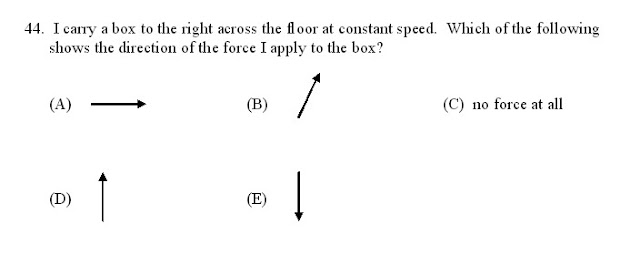In introducing work to my general physics class, I use the formulation W = F Δx cos θ. We spend a full day showing how to draw the relevant force vector and the displacement vector tail-to-tail, then use the angle between these as θ. I find that if students follow this procedure step by step, they're not likely to go wrong; but when they don't carefully draw the force and displacement vectors, or when they have a misconception about the direction of the force, then they can't calculate the work done by that force.
A day or two into the discussion of work, I want to broach the issue of carrying a box across the floor at constant speed. The work done by the carrying force in this case is ZERO. But, students are never happy about that answer, nor do they usually come to that answer on their own.
So we approach the problem in baby steps.
FIRST: I pick up a 1 kg weight. I ask the class to answer in their notebooks: what is the work done by me in lifting the weight 1 m off the ground at constant speed?
After about a minute, I go around the class with starburst candies in my hand. I give a candy to each student who has drawn, or even attempted to draw, force and displacement vectors. Whether or not their answer is right, students don't get candy if they haven't drawn and labeled these vectors.
Since both the force applied by me and displacement point upward, the angle between those vectors is zero. Thus, the work done by me is (10 N)(1 m)(cos 0) = 10 J.
SECOND: I put the weight down on the floor. I ask the class to answer in their notebooks: what is the work done by me in lowering the 1 kg weight a distance of 1 m down to the floor at constant speed?
This time, I give a piece of candy to each student who has CORRECTLY drawn the force and displacement vectors. The most common mistake here is to draw the force of me pointing down. I pick one student who made this mistake, hand him the mass, and ask him to push downward on the weight while lowering it at constant speed. He sees very quickly that he can't do it -- he must apply an upward force.
Then I go over the correct answer. Since the force of me is upward, and the displacement is downward, the angle between those vectors is 180 degrees. Thus, the work done by me is (10 N)(1 m)(cos 180) = -10 J.
THIRD, usually the next day: I give the following multiple choice question as part of a quiz:
Of course, the answer is (D). Since the box moves at constant speed, then the net horizontal force must be zero. Something doesn't need to experience a rightward force in order to move to the right! That's an issue we discussed early on in the year... but that most everyone forgot.
Once we can all agree that only an upward force is necessary to move the box to the right, then, finally, I can ask: how much work is done by me in moving the box to the right at constant speed? At this point, virtually everyone does it right. Since the force of me is up and the displacement is right, the angle between these vectors is 90 degrees. And since cos 90 = 0, I do no work.




U saved me !! Awsm....Have a test tomorrow...
ReplyDeleteDoes dat means if we carry a box over our head but we stand at a place and dont move then NO WORK IS DONE BY US ON THE BOX
ReplyDeleteDoes dat means if we carry a box over our head but we stand at a place and dont move then NO WORK IS DONE BY US ON THE BOX
ReplyDeleteYup, you are right...
ReplyDeleteThank u....I this helped me with my worksheet.
ReplyDeleteDoesn't this ignore the force that set the box in motion in the first place?
ReplyDeleteIt does, albeit with a weird justification. Remember from the Newton's laws of motion that if there are no forces acting on the body it will stay at rest or MOVE WITH A CONSTANT VELOCITY. The capitalized part is what's important here. In ideal conditions, you don't need any force to keep the object moving.
Delete